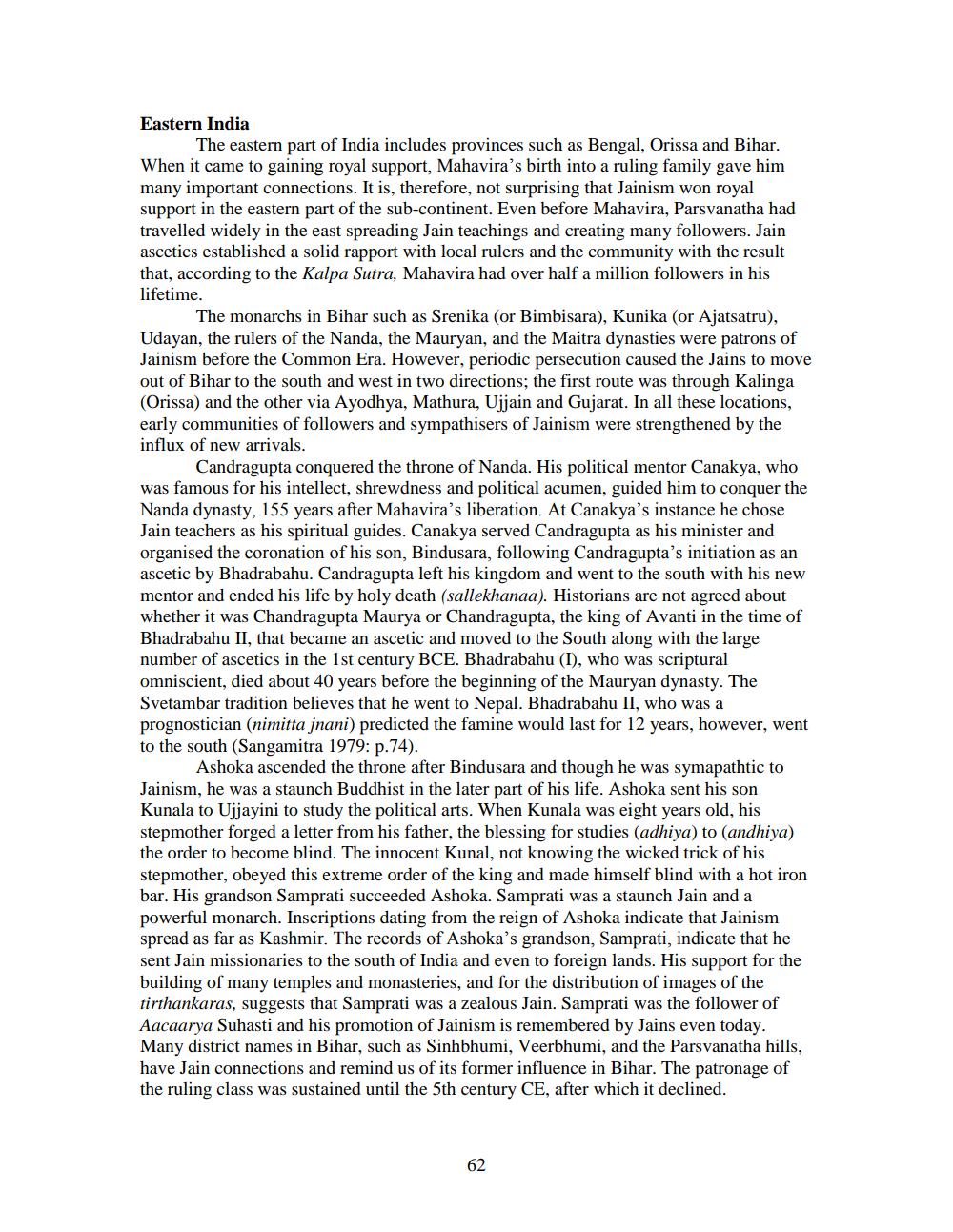________________
Eastern India
The eastern part of India includes provinces such as Bengal, Orissa and Bihar. When it came to gaining royal support, Mahavira's birth into a ruling family gave him many important connections. It is, therefore, not surprising that Jainism won royal support in the eastern part of the sub-continent. Even before Mahavira, Parsvanatha had travelled widely in the east spreading Jain teachings and creating many followers. Jain ascetics established a solid rapport with local rulers and the community with the result that, according to the Kalpa Sutra, Mahavira had over half a million followers in his lifetime.
The monarchs in Bihar such as Srenika (or Bimbisara), Kunika (or Ajatsatru), Udayan, the rulers of the Nanda, the Mauryan, and the Maitra dynasties were patrons of Jainism before the Common Era. However, periodic persecution caused the Jains to move out of Bihar to the south and west in two directions; the first route was through Kalinga (Orissa) and the other via Ayodhya, Mathura, Ujjain and Gujarat. In all these locations, early communities of followers and sympathisers of Jainism were strengthened by the influx of new arrivals.
Candragupta conquered the throne of Nanda. His political mentor Canakya, who was famous for his intellect, shrewdness and political acumen, guided him to conquer the Nanda dynasty, 155 years after Mahavira's liberation. At Canakya's instance he chose Jain teachers as his spiritual guides. Canakya served Candragupta as his minister and organised the coronation of his son, Bindusara, following Candragupta's initiation as an ascetic by Bhadrabahu. Candragupta left his kingdom and went to the south with his new mentor and ended his life by holy death (sallekhanaa). Historians are not agreed about whether it was Chandragupta Maurya or Chandragupta, the king of Avanti in the time of Bhadrabahu II, that became an ascetic and moved to the South along with the large number of ascetics in the 1st century BCE. Bhadrabahu (I), who was scriptural omniscient, died about 40 years before the beginning of the Mauryan dynasty. The Svetambar tradition believes that he went to Nepal. Bhadrabahu II, who was a prognostician (nimitta jnani) predicted the famine would last for 12 years, however, went to the south (Sangamitra 1979: p.74).
Ashoka ascended the throne after Bindusara and though he was symapathtic to Jainism, he was a staunch Buddhist in the later part of his life. Ashoka sent his son Kunala to Ujjayini to study the political arts. When Kunala was eight years old, his stepmother forged a letter from his father, the blessing for studies (adhiya) to (andhiya) the order to become blind. The innocent Kunal, not knowing the wicked trick of his stepmother, obeyed this extreme order of the king and made himself blind with a hot iron bar. His grandson Samprati succeeded Ashoka. Samprati was a staunch Jain and a powerful monarch. Inscriptions dating from the reign of Ashoka indicate that Jainism spread as far as Kashmir. The records of Ashoka's grandson, Samprati, indicate that he sent Jain missionaries to the south of India and even to foreign lands. His support for the building of many temples and monasteries, and for the distribution of images of the tirthankaras, suggests that Samprati was a zealous Jain. Samprati was the follower of Aacaarya Suhasti and his promotion of Jainism is remembered by Jains even today. Many district names in Bihar, such as Sinhbhumi, Veerbhumi, and the Parsvanatha hills, have Jain connections and remind us of its former influence in Bihar. The patronage of the ruling class was sustained until the 5th century CE, after which it declined.
62




